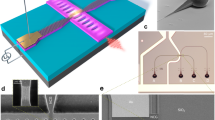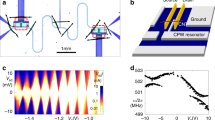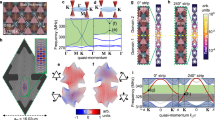Abstract
An important advancement towards optical communication on a chip would be the development of integratable, nanoscale photonic emitters with tailored optical properties. Here we demonstrate the use of carbon nanotubes as electrically driven high-speed emitters in combination with a nanophotonic cavity that allows for exceptionally narrow linewidths. The one-dimensional photonic crystal cavities are shown to spectrally select desired emission wavelengths, enhance intensity and efficiently couple light into the underlying photonic network with high reproducibility. Under pulsed voltage excitation, we realize on-chip modulation rates in the GHz range, compatible with active photonic networks. Because the linewidth of the molecular emitter is determined by the quality factor of the photonic crystal, our approach effectively eliminates linewidth broadening due to temperature, surface interaction and hot-carrier injection.
This is a preview of subscription content, access via your institution
Access options
Subscribe to this journal
Receive 12 print issues and online access
$209.00 per year
only $17.42 per issue
Buy this article
- Purchase on Springer Link
- Instant access to full article PDF
Prices may be subject to local taxes which are calculated during checkout






Similar content being viewed by others
References
Shields, J. Semiconductor quantum light sources. Nature Photon. 1, 215–223 (2007).
Jones, R. et al. Hybrid silicon integration. J Mater. Sci. Mater. Electron. 20, 3–9 (2009).
Park, H.-G. et al. A wavelength-selective photonic-crystal waveguide coupled to a nanowire light source. Nature Photon. 2, 622–626 (2008).
Berciaud, S. et al. Electron and optical phonon temperatures in electrically biased graphene. Phys. Rev. Lett. 104, 227401 (2010).
Engel, M. et al. Light–matter interaction in a microcavity-controlled graphene transistor. Nature Commun. 3, 906 (2012).
Misewich, J. A. et al. Electrically induced optical emission from a carbon nanotube FET. Science 300, 783–786 (2003).
Avouris, P., Freitag, M. & Perebeinos, V. Carbon-nanotube photonics and optoelectronics. Nature Photon. 2, 341–350 (2008).
Krupke, R. et al. Contacting single bundles of carbon nanotubes with alternating electric fields. Appl. Phys. A 76, 397–400 (2003).
Vijayaraghavan, A. et al. Ultra-large-scale directed assembly of single-walled carbon nanotube devices. Nano Lett. 7, 1556–1560 (2007).
Mann, D. et al. Electrically driven thermal light emission from individual single-walled carbon nanotubes. Nature Nanotech. 2, 33–38 (2007).
Liu, Z., Bushmaker, A., Aykol, M. & Cronin, S. B. Thermal emission spectra from individual suspended carbon nanotubes. ACS Nano 5, 4634–4640 (2011).
Khasminskaya, S., Pyatkov, F., Flavel, B. S., Pernice, W. H. P. & Krupke, R. Waveguide-integrated light-emitting carbon nanotubes. Adv. Mater. 26, 3465–3472 (2014).
Pfeiffer, M. H. P. et al. Electroluminescence from chirality-sorted (9,7)-semiconducting carbon nanotube devices. Opt. Express 19, A1184–A1189 (2011).
Jakubka, F. et al. Mapping charge transport by electroluminescence in chirality-selected carbon nanotube networks. ACS Nano 7, 7428–7435 (2013).
Jakubka, F., Grimm, S. B., Zakharko, Y., Gannott, F. & Zaumseil, J. Trion electroluminescence from semiconducting carbon nanotubes. ACS Nano 8, 8477–8486 (2014).
Ardizzone, V. et al. Strong reduction of exciton-phonon coupling in high crystalline quality single-wall carbon nanotubes: a new insight into broadening mechanisms and exciton localization. Phys. Rev. B 91, 121410 (2015).
Mori, T., Yamauchi, Y., Honda, S. & Maki, H. An electrically driven, ultrahigh-speed, on-chip light emitter based on carbon nanotubes. Nano Lett. 14, 3277–3283 (2014).
Foresi, J. S. et al. Photonic-bandgap microcavities in optical waveguides. Nature 390, 143–145 (1997).
Akahane, Y., Asano, T., Song, B.-S. & Noda, S. High-Q photonic nanocavity in a two-dimensional photonic crystal. Nature 425, 944–947 (2003).
Gérardet, J. M. et al. Enhanced spontaneous emission by quantum boxes in a monolithic optical microcavity. Phys. Rev. Lett. 81, 1110–1113 (1998).
Agio, M. & Cano, D. M. Nano-optics: the Purcell factor of nanoresonators. Nature Photon. 7, 674–675 (2013).
Barth, M., Nüsse, N., Löchel, B. & Benson, O. Controlled coupling of a single-diamond nanocrystal to a photonic crystal cavity. Opt. Lett. 34, 1108–1110 (2009).
Yoshie, T. et al. Vacuum Rabi splitting with a single quantum dot in a photonic crystal nanocavity. Nature 432, 200–203 (2004).
Lund-Hansen, T. et al. Experimental realization of highly efficient broadband coupling of single quantum dots to a photonic crystal waveguide. Phys. Rev. Lett. 101, 113903 (2008).
Lee, K. G. et al. A planar dielectric antenna for directional single-photon emission and near-unity collection efficiency. Nature Photon. 5, 166–169 (2011).
Birowosuto, M. D. et al. Movable high-Q nanoresonators realized by semiconductor nanowires on a Si photonic crystal platform. Nature Mater. 13, 279–285 (2014).
Watahiki, R. et al. Enhancement of carbon nanotube photoluminescence by photonic crystal nanocavities. Appl. Phys. Lett. 101, 141124 (2012).
Miura, R. et al. Ultralow mode-volume photonic crystal nanobeam cavities for high-efficiency coupling to individual carbon nanotube emitters. Nature Commun. 5, 5580 (2014).
Gaufrès, E. et al. Light emission in silicon from carbon nanotubes. ACS Nano 6, 3813–3819 (2012).
Quan, Q., Deotare, P. B. & Loncar, M. Photonic crystal nanobeam cavity strongly coupled to the feeding waveguide. Appl. Phys. Lett. 96, 203102 (2010).
Quan, Q. & Loncar, M. Deterministic design of wavelength scale, ultra-high Q photonic crystal nanobeam cavities. Opt. Express 19, 18529–18542 (2011).
Khan, M., Babinec, T., McCutcheon, M. W., Deotare, P. & Lončar, M. Fabrication and characterization of high-quality-factor silicon nitride nanobeam cavities. Opt. Lett. 36, 421–423 (2011).
Christofilos, D. et al. Optical imaging and absolute absorption cross section measurement of individual nano-objects on opaque substrates: single-wall carbon nanotubes on silicon. J. Phys. Chem. Lett. 3, 1176–1181 (2012).
Taflove, A., Oskooi, A. & Johnson, S. G. (eds) Advances in FDTD Computational Electrodynamics: Photonics and Nanotechnology Ch. 4 (Artech House, 2013).
Reich, S. et al. Excited-state carrier lifetime in single-walled carbon nanotubes. Phys. Rev. B 71, 033402 (2005).
Wang, F., Dukovic, G., Brus, L. E. & Heinz, T. F. Time-resolved fluorescence of carbon nanotubes and its implication for radiative lifetimes. Phys. Rev. Lett. 92, 177401 (2004).
Perebeinos, V., Tersoff, J. & Avouris, P. Radiative lifetime of excitons in carbon nanotubes. Nano Lett. 5, 2495–2499 (2005).
Högele, A., Galland, C., Winger, M. & Imamoglu, A. Photon antibunching in the photoluminescence spectra of a single carbon nanotube. Phys. Rev. Lett. 100, 217401 (2008).
Ma, X., Hartmann, N. F., Baldwin, J. K. S., Doorn, S. K. & Htoon, H. Room-temperature single-photon generation from solitary dopants of carbon nanotubes. Nature Nanotech. 10, 671–675 (2015).
Hennrich, F., Moshammer, K. & Kappes, M. M. Selective suspension in aqueous sodium dodecyl sulfate according to electronic structure type allows simple separation of metallic from semiconducting single-walled carbon nanotubes. Nano Res. 2, 599–606 (2009).
Stürzl, N., Hennrich, F., Lebedkin, S. & Kappes, M. M. Near monochiral single-walled carbon nanotube dispersions in organic solvents. J. Phys. Chem. C 113, 14628–14632 (2009).
Marquardt, C. W. et al. Electroluminescence from a single nanotube–molecule–nanotube junction. Nature Nanotech. 5, 863–867 (2010).
Acknowledgements
W.H.P. Pernice acknowledges support by the Deutsche Forschungsgemeinschaft (DFG) grants PE 1832/1-1 & PE 1832/1-2 and the Helmholtz society through grant HIRG-0005, as well as support by the DFG and the State of Baden-Württemberg through the DFG-Center for Functional Nanostructures (CFN). R. Krupke and F. Pyatkov acknowledge funding by the Volkswagen Foundation. B.S. Flavel acknowledges support by the DFG grant FL 834/1-1. F. Hennrich, M.M. Kappes and R. Krupke acknowledge support by Helmholtz society through program STN and by the KNMF. We thank S. Kühn and S. Diewald for the help with device fabrication and P. Löser for the preparation of CNT suspensions.
Author information
Authors and Affiliations
Contributions
The experiment was conceived and designed by W.H.P.P. and R.K. F.P., V.F. and S.K. fabricated the devices and carried out the experiments. The carbon nanotube suspensions were provided by F.H., B.S.F. and M.M.K. V.F. performed the simulations. The data were analysed by F.P., V.F., S.K., R.K. and W.H.P.P. All the authors contributed to discussions and manuscript preparation.
Corresponding authors
Ethics declarations
Competing interests
The authors declare no competing financial interests.
Supplementary information
Supplementary information
Supplementary information (PDF 2517 kb)
Rights and permissions
About this article
Cite this article
Pyatkov, F., Fütterling, V., Khasminskaya, S. et al. Cavity-enhanced light emission from electrically driven carbon nanotubes. Nature Photon 10, 420–427 (2016). https://doi.org/10.1038/nphoton.2016.70
Received:
Accepted:
Published:
Issue Date:
DOI: https://doi.org/10.1038/nphoton.2016.70
This article is cited by
-
An electroluminescent and tunable cavity-enhanced carbon-nanotube-emitter in the telecom band
Nature Communications (2023)
-
Coherent momentum control of forbidden excitons
Nature Communications (2022)
-
Contact spacing controls the on-current for all-carbon field effect transistors
Communications Physics (2021)
-
Two-dimensional materials for light emitting applications: Achievement, challenge and future perspectives
Nano Research (2021)
-
Nanophotonic engineering of far-field thermal emitters
Nature Materials (2019)



